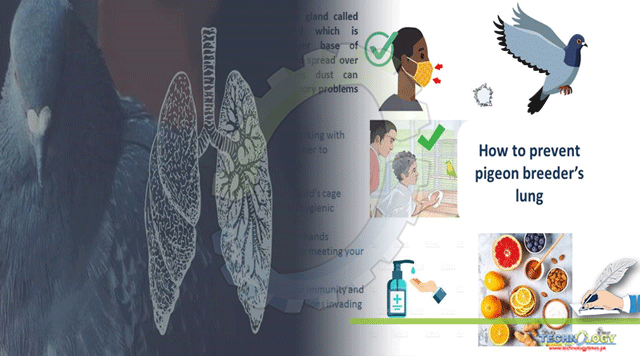Hiring and breeding birds is an amusement and frequently practiced in several countries, so there becomes an obvious link between human and birds.

By Rabia Naeem khan,Faheem Abbas,Areej Fatima
Introduction
Although the connection is fascinating but the most disturbing fact is that there is a potential risk of zoonosis. These communicable diseases are not only of bacterial, viral or fungal origin in fact some are hypersensitivities to specific or nonspecific various antigens.
This pigeon related disease ,which is commonly seen in people who are either keeping them or linked by their profession to them, is hypersensitivity induced lung infection is rare and undetermined cause of severe breathlessness which leads to low oxygen level in blood.
Etiology
Exposures to air borne avian antigens in bird’s dropping and waxy proteins that cover the feathers of birds provoke hypersensitivity reaction in susceptible host. Only a small proportion of population develops the clinical disease due to genetic predisposition. Prevention from exposure to antigen is the main treatment method for this case, but in case of chronic form that results from long term exposure supportive therapy is advised. The associated allergic reactions may be chronic to fatal damaging the systemic parts of human body.
Clinical signs
Three forms are reported based on extent of exposure, genetic susceptibility and host immune status. The acute form is self-resolving and develops due to high level of sudden antigenic exposure; clinical signs develop after 4 to 12 hours that indicate high fever, sudden chills, and muscle pain, loss of appetite, fatigue and nonproductive cough. Joint pain is absent in this case.
The sub-acute type occurs due repeated low amount of inhaled antigens while the symptoms are more dangerous leading to exhaustion and severe painful coughing. However, it can be self-resolved after cut off of exposure but transform into chronic if the antigen exposure is prolonged.
The chronic form represents strong cough (usually productive), asthma, weight loss, anorexia, strong exhaustion and progressive dyspnea or lung damage. Chronic form is potential threat cause progressive, severe irreversible damage to lung and even death.
How do we diagnose the case?
If a person suffers from chest tightness, repeated cough, fever and is in contact with birds or she may go to doctor for diagnosis. The clinician will surely ask for history because it is really important for diagnosing pigeon breeder’s lung infection . X-ray or CT scan are helpful in showing the extent of pathological conditions of lungs for characterizing infection forms. ELISA serves as a screening tool for diagnosis and is usually performed with patient serum. The clinician may also ask for sputum analyses for confirming the infection.
Treatment
As infection is hypersensitivity induced so medicines are used that suppresses immune system and decrease inflammation in conditions such as asthma may be useful. The avoidance of the of antigen may not result in complete resolution of symptoms
steroids are indicated for the treatment of acute, sub-acute and for chronic infection that is intensive or progressive. Long-term steroid therapy for the treatment should be considered only if objective improvements in clinical signs, pulmonary function, or radiographic abnormalities are documented.
How can we reduce the risk of exposure?
Although the threat is here but professions related to breeding pigeons and people who are interesting in making them pet are not discouraged. The only recommended long-term treatment is avoidance of the avian proteins that trigger this disease. All breeders that suspect any kind of sensitivity reaction to birds should follow some instructions: wear mask,cap and loft coat while working in shed . Watering pots ,wearing items and feeders should be disinfected. Avoid old moldy straw from nest boxes as it cause similar pneumonitis known farmer’s lung.
Figure 1 preventive measures against birds fancier’s lung disease
Prevention and early diagnosis of those at risk of developing chronic lung disease requires adequate knowledge, awareness and understanding of the disease and by the medical professional.
The knowledge about these uncommon and fatal diseases should be disseminated among pigeon’s breeders, sellers and common public. Awareness through social media, newspaper, television, posters and awareness campaigns will be very helpful in educating a layman.
Authors : rabia naeem khan,faheem abbas and areej fatima from college if veterinary and animal sciences